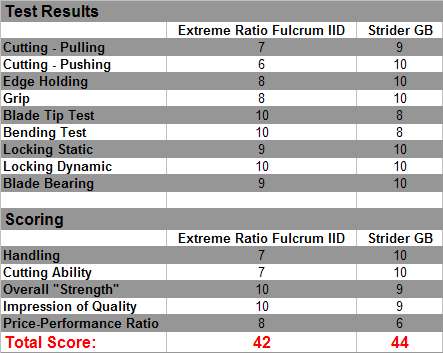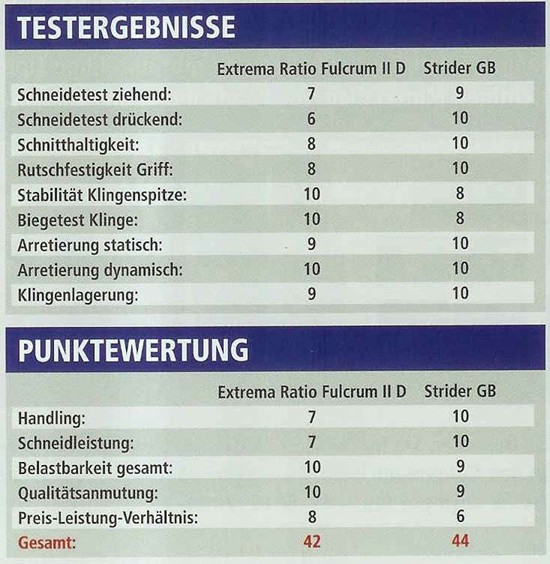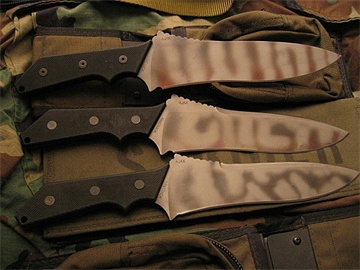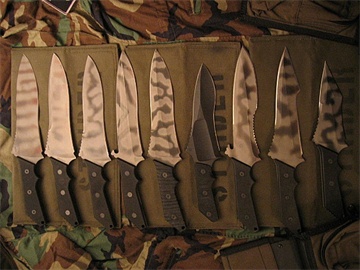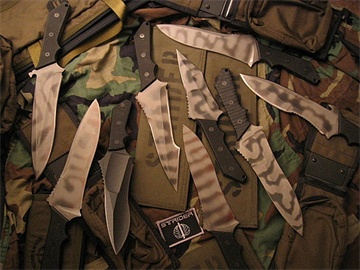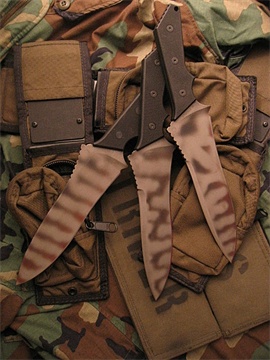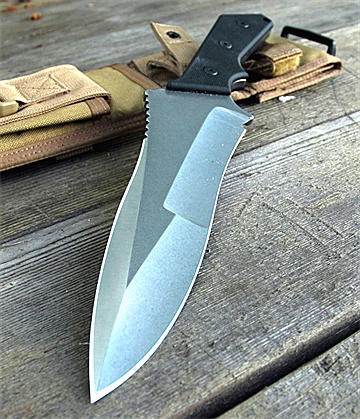Strider FAQ
- What is the history on the MARSOC SMF project?
- Information regarding USMC SOCOM Detachment 1.
- What is the V42/RF?
- What is the AJAX?
- Comparison test : Extreme Ratio Fulcrum IID vs. Strider GB by Messer Magazine
1. What is the history on the MARSOC SMF project?
Per Mick Strider: “Our folder was selected by SOCOM to be an issue item. This is super cool for us on many levels. I don’t really need to go into that….
Here is the part that applies to you:
Our plan is this; In the beginning there will be only matched sets of knives. For every knife we send to SOCOM, a matching numbered knife will be sold in the private market. A portion of the cost of the civilian knife will go to the production of the government one.
This does a couple of things….First, it helps us provide the knife to the government at a cost that is effective. Secondly, it allows you to have a knife whose twin brother is out there kicking ass and taking names!
Let’s say you buy folder number C0069. Well out there somewhere is a highly trained super hero using the knife M0069 that YOU helped them to have!
Once we have the ability to match governmental demand, we will make a normal non numbered version.”
Strider made an initial run of 150 numbered knives for civilians (C0001 – C0150). They have since made the SMF a catalog/production knife, which has changed slightly since the first run. The Gen II SMFs have the Hinderer Lock Bar Stabilizer and a scallop in the locking bar.
2. Information regarding USMC SOCOM Detachment 1.
The USMC-SOCOM Connection
By Otto Kreisher
March 2003
Otto Kreisher is a reporter for Copley News Service.
Source: Navy League of the United States
In a nondescript office at Camp Pendleton, Calif., Lt. Col. Robert Coates and his staff are screening hundreds of applicants for what soon may be considered a prime assignment for Marine Corps personnel.
The Corps is forming a new unit at Pendleton that could bridge the artificial divide between the Marine Corps and the U.S. Special Operations Command (SOCOM) that has existed for 16 years. SOCOM, founded in 1987, is composed of specialized units from the nation's other armed services--except the Marine Corps.
But that may soon change. With the global war on terrorism putting greater demands on all of the armed services, the Marine Corps is working on ways to lighten the much heavier load imposed on SOCOM since the 9/11 terrorist attacks. One way, Corps officials say, is the formation of a Marine unit that could be the first to deploy as an element of SOCOM. Coates, now director of the Marine special operations training group at Pendleton, will command the Corps' Special Operations Command Detachment of 81 Marines and five Navy corpsmen.
"It's all about how we can best contribute ... complement, supplement" the special operations forces, said Lt. Gen. Emil R. Bedard, the Corps' assistant commandant for programs, policies, and operations.
A Bridge-Building MOA
The initiative to promote a much closer working relationship between the Marine Corps and SOCOM is the result of a memorandum of agreement (MOA) signed in November 2001 by then-Commandant Gen. James L. Jones and Air Force Gen. Charles R. Holland, commander of the Special Operations Command. "We need to move the Marine Corps and special operations forces [SOF] closer together, to establish the framework for building bridges between the two organizations," Jones said at a defense writers' breakfast in November 2002.
The Pentagon's senior leadership wants more special operations forces, Jones explained, "so we are looking for ways to use Marine forces to go into what were previously SOF missions that we can do and were trained to do."
There are "some cultural things to overcome" as well as certain "institutional ties and confidence-building measures that we have [to deal with]," Jones said. But, he quickly added, "I think it is going to happen and I think it is going to be very capable and very good."
The Marines' interest in working much more closely with SOCOM comes at a time when the SOCOM forces have been deploying at their highest operational tempo since Vietnam. Special operations troops have been increasingly in demand for use in unconventional conflicts since the end of the Cold War. They currently are heavily engaged around the world in the global war on terrorism, and played a crucial role in the U.S.-led victory over the Taliban and al Qaeda fighters in Afghanistan. Following that success, Secretary of Defense Donald H. Rumsfeld gave SOCOM the authority to plan and execute antiterrorism missions on its own initiative and to seek support from regional combatant commanders if necessary.>
New-Found Respect
The new focus on and respect for SOCOM is in sharp contrast to the years following World War II, when unconventional warriors enjoyed only episodic support from the nation's senior military leadership. The Marine Raider battalions that conducted a number of daring strikes against the Japanese during the early years of World War II, for example, were disbanded when the Corps expanded to six divisions in preparation for the massive amphibious assaults in the Pacific.
The largely unconventional conflict in Vietnam led to a proliferation of elite units, including the Army's Green Berets, the Air Force's Air Commandos, and the Navy's SEALs--who evolved from the underwater demolition team "frogmen" of World War II and Korea. But those units were cut back sharply after Vietnam.
In 1980, special forces of various types, hastily formed into a special mission unit, were assigned to the fatally flawed attempt to rescue American hostages in Iran. The 1983 Grenada operation is remembered in part for the poorly planned missions assigned to the SEALs and the secret Delta Force. Several U.S. military personnel died, partly because of equipment failures, while attempting reconnaissance of the Point Salines airport. In addition, an attempt to rescue an American thought to be held prisoner in an old fort was thwarted by a hail of heavy gunfire.
In 1987, Congress stepped in to upgrade the status and improve the capabilities of the nation's special forces by creating the Special Operations Command, giving it its own budget and four-star commander.
The command today has about 46,000 personnel in its active and reserve units. It includes Army Special Forces (the Green Berets), Rangers, and the 160th Special Aviation Regiment; Navy SEALs, special warfare boat units, and SEAL delivery units; and Air Force Special Operations airlift units, AC-130 gunships, and special tactics teams. The Army, Air Force, and Navy special operations commands are components of SOCOM.
The Bush administration's fiscal year 2004 defense budget proposes to increase SOCOM funding to $4.5 billion, a 50 percent increase over the amount appropriated for FY 2003. The command's end strength would increase by 1,890 personnel, primarily to expand the 160th Special Aviation Regiment.
Elite Warriors
The Marine Corps has never assigned any of its units to SOCOM, but hundreds of individual Marines have served with special operations forces on exchange duty. There currently are 105 Marines in the elite force--serving as helicopter pilots, as intelligence officers, and in other specialized duties.
Marine Brig. Gen. Dennis J. Hejlik is the Special Operations Command's chief of staff, and Marine Maj. Gen. John F. Satler is commanding Task Force Horn of Africa, which includes a large contingent of SOCOM warriors searching for terrorists in that volatile region.
In February, Master Gunnery Sgt. Joseph G. Settelen received the Special Operations/Low Intensity Conflict Achievement Award, presented by the National Defense Industrial Association, for service that included classified duties around the world with an unnamed Defense Department unit.
When SOCOM was being formed in 1987, however, the Corps refused to assign any Marine units to it, arguing that it had no fighters to spare.
Instead, the Corps began to train its Marine Expeditionary Units (MEUs) to conduct 23 particularly difficult types of missions--several of which, Bedard said, "fall into the lower end of the special ops [operations] spectrum." Certification to perform those missions, which include noncombatant evacuation operations (NEOs) and the tactical recovery of downed aircraft and personnel (TRAP), earns an MEU the designation "special operations capable," or SOC.
Rescues and Evacuations
Marine units already have conducted real-world NEOs in Somalia, Liberia, and elsewhere. The Corps' most famous TRAP mission was the daring rescue of Air Force Capt. Scott O'Grady after he was shot down over Bosnia in 1995. The Marines also have relieved SOCOM of certain burdens, replacing special-forces personnel who were training troops in the Republic of Georgia, and sharing SOCOM's training and advisory missions in the Philippines. When a Marine brigade became the first sizable U.S. conventional force in Afghanistan, it worked closely with the special operations units already on the ground in-country.
"In Afghanistan, we did everything," Bedard said. "Everything" included the transport of special operations troops, the evacuation of casualties, providing fire support, the refueling of special operations helicopters, and cooperating in various intelligence efforts. Those kinds of shared missions, he said, "are all the more reason we should work together."
Each MEU also has a number of highly trained reconnaissance Marines, who work very closely with the SEAL teams that deploy with the Corps' expeditionary units.
The MOA signed in November 2001 was in large part, Bedard said, an outgrowth of: (1) the close cooperation developed between the Marine Corps and SOCOM in the political and budgetary fight to save the threatened V-22 Osprey tiltrotor aircraft program; and (2) the joint combat missions the two elite organizations teamed up for in Afghanistan.
The Marines have been the leading advocates of the Osprey, but the Air Force Special Operations Command also urgently wants 50 or more Ospreys to replace its current helicopter fleet.
The MOA led to the formation of eight Marine-SOCOM working groups, Bedard said, to address such issues as doctrine, equipment, tactics, techniques, and joint training.
The Marine unit intended for eventual assignment to SOCOM is expected to include a 22-person headquarters element, 30 reconnaissance Marines, 28 intelligence specialists, and a six-man team to coordinate fire support. The recon element will include four six-man teams led by staff sergeants and a command staff led by a captain. The intelligence section, led by a major, will include teams to handle signals intelligence, human intelligence exploitation, radio recon, and an "all-source" fusion team to assemble information from various sources, then analyze and distribute it to all who need it.
The fire support unit--composed of three ANGLICO (Air Naval Gunfire Liaison Company) Marines, three radio operators, and a forward air controller--will be led by a field artillery major. The detachment is expected to start training on its own this June, and to join the SEAL squadron in October for joint training in Coronado (Calif.). If the concept is validated and the unit demonstrates its readiness, Marine officials said, the detachment probably would deploy for the first time in April 2004.
Cutting-Edge Missions
The detachment will focus on four types of missions: special reconnaissance, short-duration combat strikes, the internal defense of foreign nations, and the support of international coalitions--the training and advisory role Marines already are playing in Georgia and in the Philippines, for example.
If the two-year trial is successful, the Pendleton unit could be expanded or duplicated elsewhere, Marine officials said.
Jones said in November that creation of the special operations unit stems from his earlier decision to make force reconnaissance a career MOS (military occupational specialty) for Marines. "That gives you ... [a] higher-end specialty that becomes attractive to Special Operations Command," he said.
The Marines are confident that their proposed new unit will be successful, but a SOCOM spokesman emphasized that the concept is still being studied. "There has been no determination of what we are going to do," said Army Col. William Darley. "We are looking at the interoperability of having the Marines ... [assigned] as a detachment to the Naval Special Operations Command. But no final decision has been made," he said.
Jay Farrar, a national security analyst at the Center for Strategic and International Studies, said the proposed integration of Marine units with SOCOM would benefit both organizations. "They [the Marines] can take advantage of the cutting-edge training ideas the Special Ops Command is always discovering," said Farrar, a retired Marine officer. "And SOCOM can take advantage of what the Marines are doing in small-unit operations."
3. What is the V42/RF?
Per Mick Strider: "The first V42/RF was made to Honor Col. Thomas Herman, whom was inducted into the Special Operations Warrior Foundation Hall of Honor in Nov. 2003. Additionally, Col. Herman was the individual that evacuated the Commander And Chief on 9/11.
We at Strider Knives have been given a great honor. Both our Raider Dagger CC and the V42/RF have been chosen by their founding families to carry on the tradition. What this means is that most of the knives produced will be sent to the US Government for issue and awards. The Raider Dagger CC and the V42/RF will remain custom only pieces, with all of the STRIDER models being issue items"
Per Duane Dwyer: "The V42 is actually Model RF by Strider nomenclature and is our evolved version of the famous V42 Dagger designed for and carried by the First Special Service Forces in 1942."
The V42/RF Specs:
Blade is .250" x 7.5" x .875"
Blade material is S30V
Guard and Butt Spike are 6AL4V Ti
Handle is glass-filled Delron
(Photo by Strider Knives Inc.)
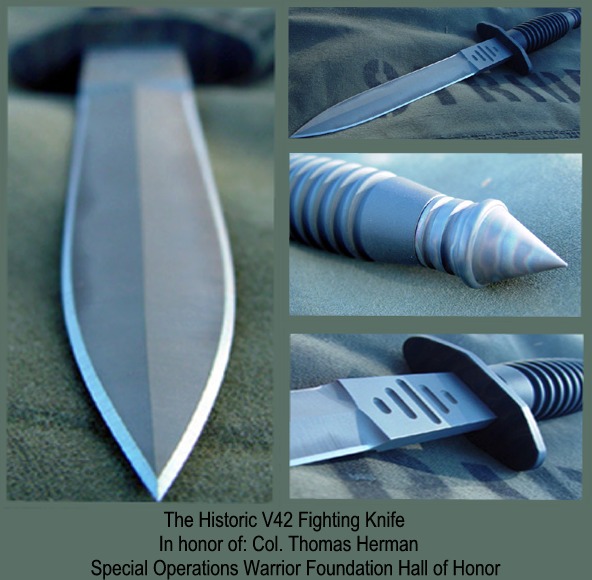
4. What is the AJAX?
The AJAX (a.k.a. Gut Shovel) is a Mick Strider Custom fixed blade knife.
There have been a number of different variations of the AJAX knife. However, there is "The ONE" that started it all. "The ONE" particular standard AJAX has a 8" cutting edge integrated handguards with thumb notches, single finger grip, checkered Black G-10 Scales bolted in place with a thong hole for lanyard/wrist-loop attachment. This knife was initially offered in 3 configurations: Single Edge, Doubled Edge, or Single Edge with upper Swedge. All 3 variations were made in a full flat ground spear point geometry bearing a mild recurve. This blade configuration and length allow for chopping and stabbing -- it's 8" of cutting edge are ideal for maximum penetration through thick layers of clothing and multiple rigs, with little to no trouble in reaching vital organs-- as well as, detailed / fine cutting / slicing when choking up, and gripping the upper notches ahead of the guard. Another Innovative feature of the Original AJAX is the Sheath. SOE Nylon Sheath with Kydex insert, and Zippered pouch for basic meds., flares, or whatever survival items you may deem a necessity.
"The ONE" top to bottom: Single Edged AJAX,
|
|
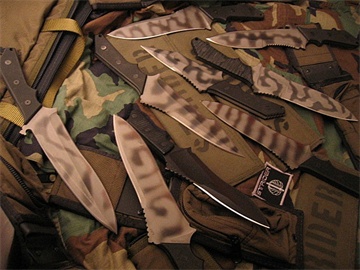 | 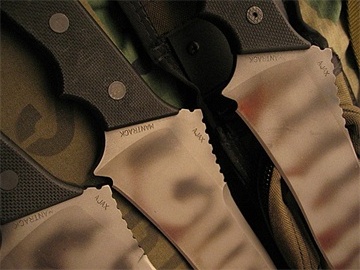 |
Stonewashed AJAX | "The ONE" AJAX Stampings |
5. Comparison test : Extreme Ratio Fulcrum IID vs. Strider GB by Messer Magazine
All images are copyright protected by "Messermagazin, 1/2005
Scans by AlexCeh on USN
Translation by K-T on USN
Methods of testing:
Both candidates underwent hard testings. To test stability of blade and handle a hydraulic presss was used - every knife will break with that one.
1) Cutting Test - Pulling
Test medium here was tha Polyporpylen rope with an 8mm (0.315") diameter. Test was, how well the knife will cut through that rope with a pulling cut and normal pressure applied. Several trials were done one after another, the number of cuts needed to finally cut through the rope were noted. At the end of that test an average was calculated. These were compared and points given in analogy to the cutting performance.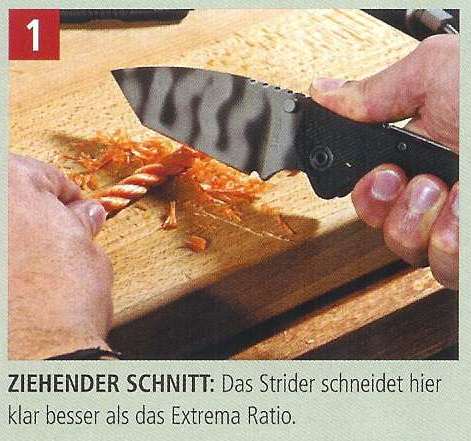
2) Cutting Test - Pushing
Test medium was again the 8mm (0.315") Polypropylen rope. Test was, how good the knife would cut through the rope only by pushing down, no longitudinal movement. Here the blade was pressed down hard with both hands. It was measured, how deep the blade could penetrate the rope or how often a rocking/swaying (?) motion ws needed to cut through the rope. At the end of this test, again an average was calculated. These were compared and points given in analogy to the cutting perfomance.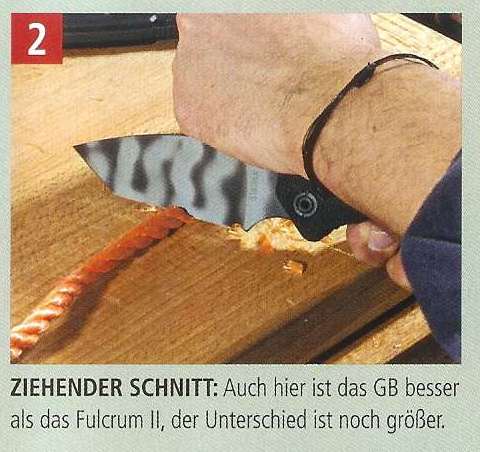
3) Edge Retention Test
To test the staiblity of the edge and the wear while using it, a very nasty material was cut : a steel square tube (ST-37). The edge was pulled over the edge of that square tube several times with light pressure. In between these cuts the edge was tested on the rope to compare how good or bad it could cut. There by it became clear, that the original edge and sharpness was lost very fast, still both knives could cut even after several cuts on the square tube. The Strider S30V blade proved to keep its edge slightly better.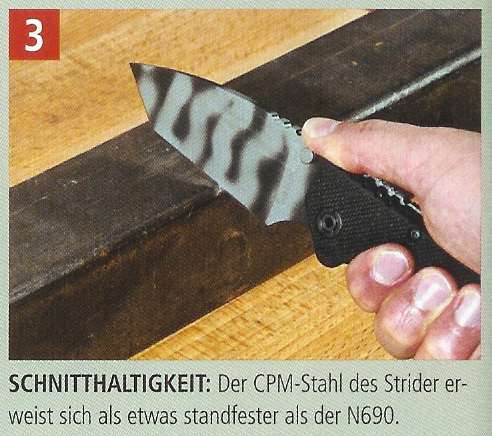
4) Grip - Test
The knife's blade was mounted to a vice, the handle and hand were rubbed with the good and well known Ballistol weapon oil. This was done to simulate the effect of dirt, blood and humidity. Here the secure grip and/or how easily it would slip out of the user's hand was tested. The subjective results were converted into points. Here the Strider proved to have a lot of grip in oily condition (not less than dry), while the Extrema Ratio was very slippery due to the smooth/slick surface.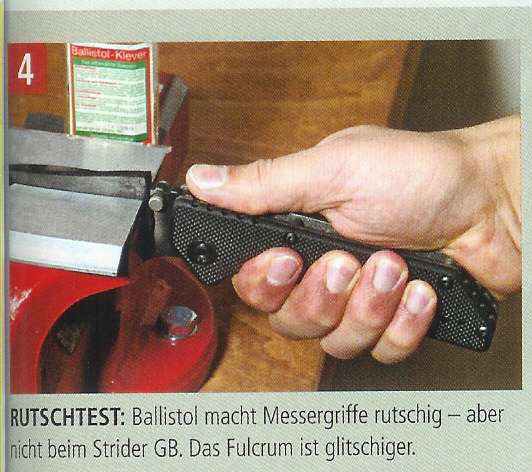
5) Blade Tip Test
To test the stability of the blade tip and also the whole knife construction while stabbing, both knives were pushed straight through a 2mm (0.079") thick steel plate (ST-37 construction steel). Here a hydraulic press was used. The Strider GB bent noticably to the side, but flexed back into its inital position. At a hydraulic pressure of 85bar the tip broke off - exactly at the point of time where it completely penetrated the steel plate. The Extrema Ratio blade was "not impressed" (?), the locking bent at a pressure of 65bar. The bolt safeguard of the lock was not activated on purpose, to prevent the handle from blowing/breaking appart. With that safety a higher pressure would have been possible and the Fulcrum might have also penetrated the steel plate.
6) Lock Test
Both knives were first tested with spine-whacking, to perform a dynamic test to the lock. Here the back of both blades were repeatedly beaten onto a hard surface. Both knives passed the test without difficulties. Then a static test to the lock was performed with a hydraulic press. With a slowly raising pressure across the blade pivot, the maximum load was tested. The Fulcrums bolt/hammer of it's lock failed at a pressure of 70bar, releasing it's blade (without bolt safety/safeguard). With activated bolt safety a higher load would have been possible, until the whole handle would break apart. the liner locking mechanism of the Strider GM kept up until 80bar, untl the liner failed. The extreme load/force/stress did not leave any marks on either knives.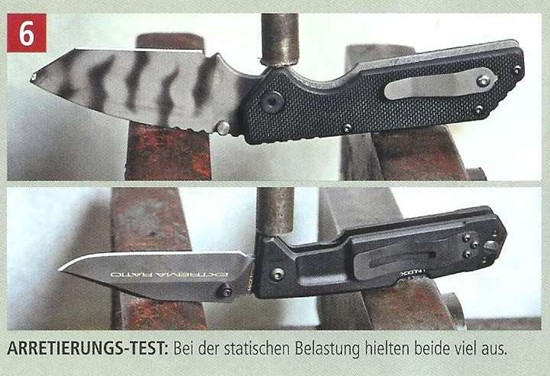
7) Blade Bending Test
Both blades were one after another put onto two pads/bases and put under presssure with the hydraulic press in the middle. The Strider GB blade proved to be of etreme elasticity - in spite of the powdermetallic steel (S30V). Not before a pressure of 83 bar (which resembles a high load in transverse direction), the blade broke into several parts. At that point of testing a bending degree of nearly 30° was reached. The extreme thick blade of the Extreme Ratio Fulcrum II passed that test nearly unimpressed. It kept up until the hydraulics maximum pressure of 85 bar was reached and moved back nearly to it's initial position. A slightly deviation of one to two degree (angular transformation) was left.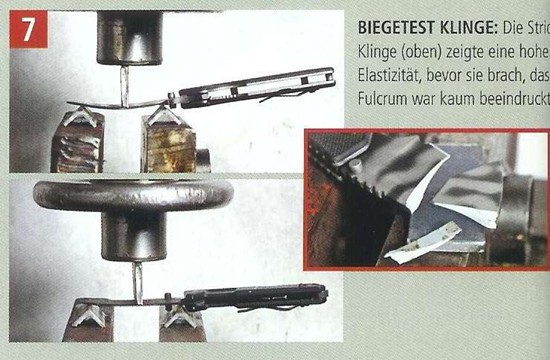
8) Bearing Test
To test the bearing and handle construction, both knives were put under vertical load/pressure with the hydraulic press. The knives were positioned in such way, that the handle was on the right, the blade on the left side based onto a block, putting pressure directly onto the bearing. The hydraulic press support point was immediatly behind the pivot. The Strider GB proved its impressive flexibility of its handle, which flexed back into its original state. Here the Ti-liners showed their strenght and flexibility. At a pressure of 80bar the outer ring of the pivot blew off. The Extrema Ratio Fulcrum also withstood 80bar, a permanent deformation of the handles stayed.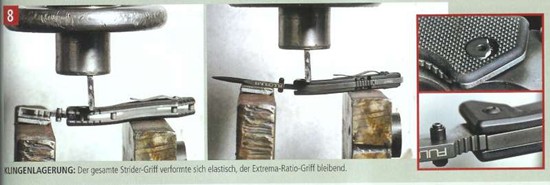
Comparison
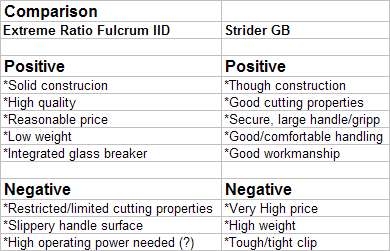
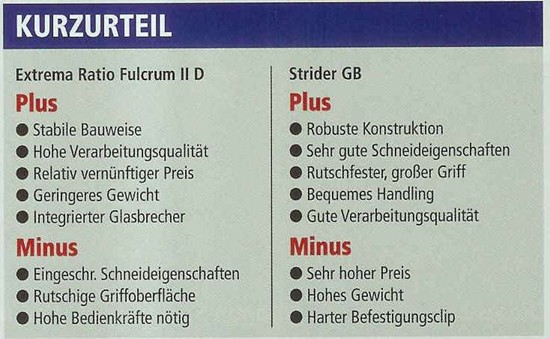
Scores